Page 665 of 1943
DI±62
± DIAGNOSTICSENGINE
2001 PRIUS (RM778U)
INSPECTION PROCEDURE
HINT:
Read freeze frame data using TOYOTA hand±held tester or OBD II scan tool. Because freeze frame records
the engine conditions when the malfunction is detected, when troubleshooting it is useful for determining
whether the vehicle was running or stopped, the engine warmed up or not, the air±fuel ratio lean or rich, etc.
at the time of the malfunction.
1 Check air induction system (See page SF±1).
NG Repair or replace.
OK
2 Check injector injection (See page SF±12).
NG Replace injector.
OK
3 Check mass air flow meter and engine coolant temp. sensor
(See page SF±22 and SF±49).
NG Repair or replace.
OK
4 Check for spark and ignition (See page IG±1).
NG Repair or replace.
OK
Page 670 of 1943

P03792
± DIAGNOSTICSENGINE
DI±67
2001 PRIUS (RM778U)
(f) Turn ignition switch OFF and wait at least 5 seconds.
INSPECTION PROCEDURE
HINT:
�If is the case that DTC besides misfire is memorized simultaneously, first perform the troubleshooting
for them.
�Read freeze frame data using TOYOTA hand±held tester or OBD II scan tool. Because freeze frame
data records the engine conditions when the malfunction is detected, when troubleshooting it is useful
for determining whether the vehicle was running or stopped, the engine warmed up or not, the air±fuel
ratio lean or rich, etc. at the time of the malfunction.
�When the vehicle is brought to the workshop and the misfire is not occurred, misfire can be confirmed
by reproducing the condition or freeze frame data. Also, after finishing the repair, confirm that there
is no misfire. (See the confirmation driving pattern)
�When either of SHORT FT #1, LONG FT #1, SHORT FT #2 or LONG FT #2 in the freeze frame data
is besides the range of ±20%, there is a possibility that the air±fuel ratio is inclining either to ºrichº
(±20% or less) or ºleanº (+20% or more).
�When COOLANT TEMP in the freeze frame data is less than 80°C (176°F), there is a possibility or
misfire only during warming up.
�In the case that misfire cannot be reproduced, the reason may be because of the driving with lack or
fuel, the use of improper fuel, a stain of ignition plug, and etc.
1 Check wire harness, connector and vacuum hose in engine room.
CHECK:
(a) Check the connection conditions of wire harness and connector.
(b) Check the disconnection, piping and break of vacuum hose.
NG Repair or replace, then confirm that there is no
misfire. (See the confirmation driving pattern)
OK
2 Check spark plug and spark of misfiring cylinder.
PREPARATION:
Remove the spark plug (See page IG±1).
CHECK:
(a) Check for carbon deposits on electrode.
(b) Check electrode gap.
OK:
(a) No large carbon deposit present.
Not wet with gasoline or oil.
(b) Electrode gap: 1.0 ± 1.2 mm (0.039 ± 0.047 in.)
PREPARATION:
(a) Install the spark plug to ignition coil and connect the igni-
tion coil connector to ignition coil.
Page 675 of 1943
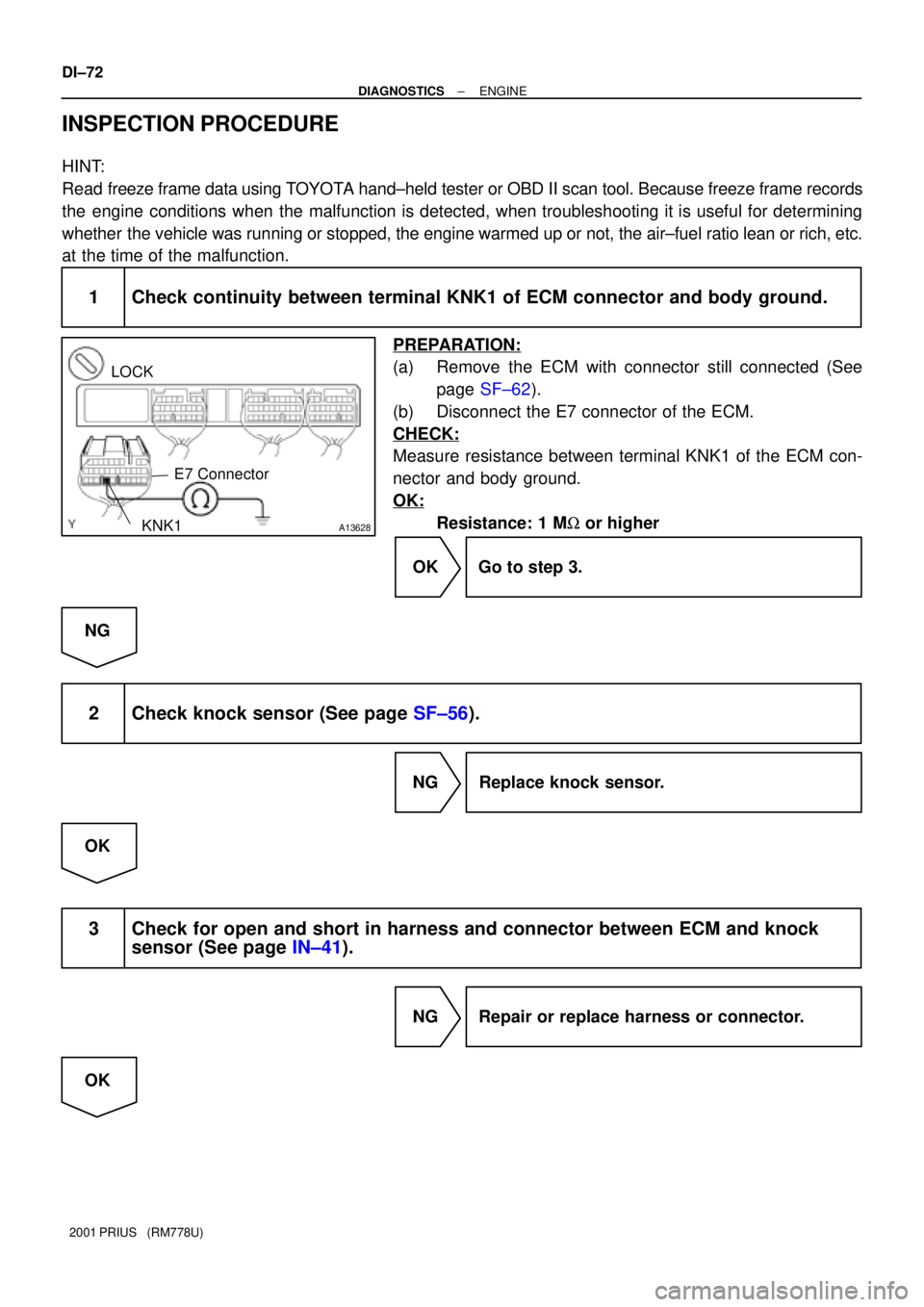
A13628
E7 Connector LOCK
KNK1
DI±72
± DIAGNOSTICSENGINE
2001 PRIUS (RM778U)
INSPECTION PROCEDURE
HINT:
Read freeze frame data using TOYOTA hand±held tester or OBD II scan tool. Because freeze frame records
the engine conditions when the malfunction is detected, when troubleshooting it is useful for determining
whether the vehicle was running or stopped, the engine warmed up or not, the air±fuel ratio lean or rich, etc.
at the time of the malfunction.
1 Check continuity between terminal KNK1 of ECM connector and body ground.
PREPARATION:
(a) Remove the ECM with connector still connected (See
page SF±62).
(b) Disconnect the E7 connector of the ECM.
CHECK:
Measure resistance between terminal KNK1 of the ECM con-
nector and body ground.
OK:
Resistance: 1 MW or higher
OK Go to step 3.
NG
2 Check knock sensor (See page SF±56).
NG Replace knock sensor.
OK
3 Check for open and short in harness and connector between ECM and knock
sensor (See page IN±41).
NG Repair or replace harness or connector.
OK
Page 678 of 1943
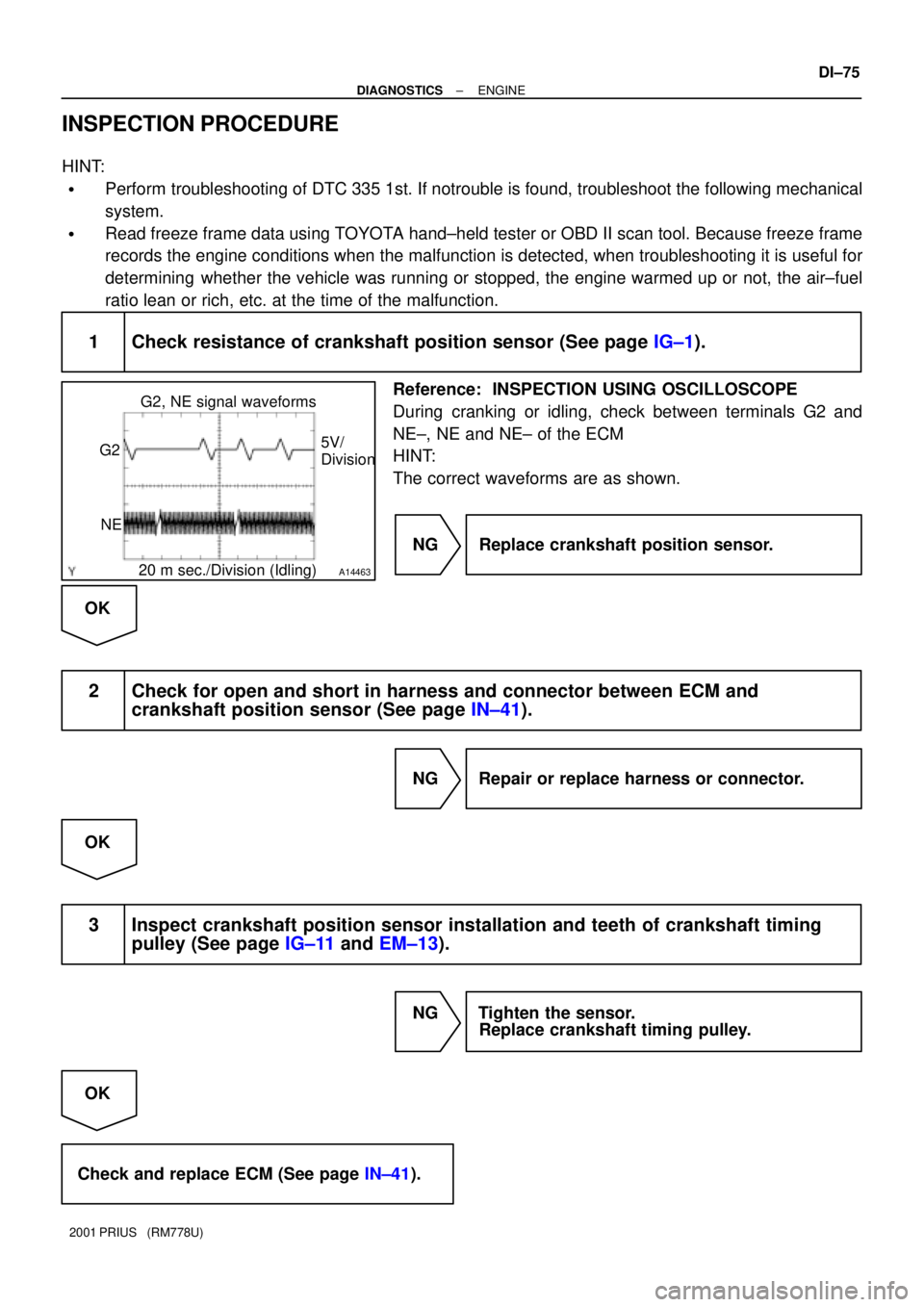
A14463
G2, NE signal waveforms
5V/
Division G2
NE
20 m sec./Division (Idling)
± DIAGNOSTICSENGINE
DI±75
2001 PRIUS (RM778U)
INSPECTION PROCEDURE
HINT:
�Perform troubleshooting of DTC 335 1st. If notrouble is found, troubleshoot the following mechanical
system.
�Read freeze frame data using TOYOTA hand±held tester or OBD II scan tool. Because freeze frame
records the engine conditions when the malfunction is detected, when troubleshooting it is useful for
determining whether the vehicle was running or stopped, the engine warmed up or not, the air±fuel
ratio lean or rich, etc. at the time of the malfunction.
1 Check resistance of crankshaft position sensor (See page IG±1).
Reference: INSPECTION USING OSCILLOSCOPE
During cranking or idling, check between terminals G2 and
NE±, NE and NE± of the ECM
HINT:
The correct waveforms are as shown.
NG Replace crankshaft position sensor.
OK
2 Check for open and short in harness and connector between ECM and
crankshaft position sensor (See page IN±41).
NG Repair or replace harness or connector.
OK
3 Inspect crankshaft position sensor installation and teeth of crankshaft timing
pulley (See page IG±11 and EM±13).
NG Tighten the sensor.
Replace crankshaft timing pulley.
OK
Check and replace ECM (See page IN±41).
Page 679 of 1943
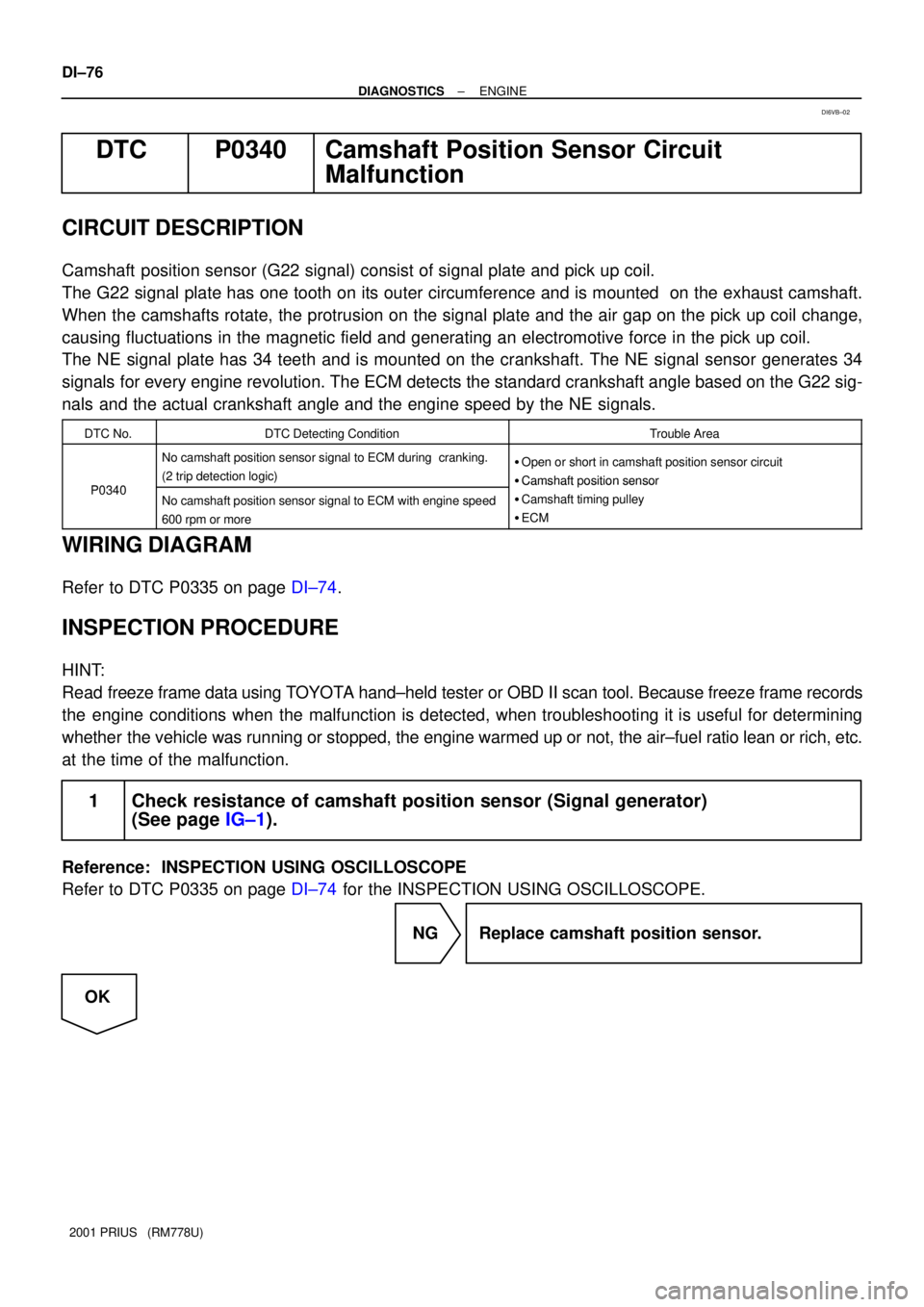
DI±76
± DIAGNOSTICSENGINE
2001 PRIUS (RM778U)
DTC P0340 Camshaft Position Sensor Circuit
Malfunction
CIRCUIT DESCRIPTION
Camshaft position sensor (G22 signal) consist of signal plate and pick up coil.
The G22 signal plate has one tooth on its outer circumference and is mounted on the exhaust camshaft.
When the camshafts rotate, the protrusion on the signal plate and the air gap on the pick up coil change,
causing fluctuations in the magnetic field and generating an electromotive force in the pick up coil.
The NE signal plate has 34 teeth and is mounted on the crankshaft. The NE signal sensor generates 34
signals for every engine revolution. The ECM detects the standard crankshaft angle based on the G22 sig-
nals and the actual crankshaft angle and the engine speed by the NE signals.
DTC No.DTC Detecting ConditionTrouble Area
P0340
No camshaft position sensor signal to ECM during cranking.
(2 trip detection logic)�Open or short in camshaft position sensor circuit
�Camshaft position sensor
P0340No camshaft position sensor signal to ECM with engine speed
600 rpm or more
�Camshaft osition sensor
�Camshaft timing pulley
�ECM
WIRING DIAGRAM
Refer to DTC P0335 on page DI±74.
INSPECTION PROCEDURE
HINT:
Read freeze frame data using TOYOTA hand±held tester or OBD II scan tool. Because freeze frame records
the engine conditions when the malfunction is detected, when troubleshooting it is useful for determining
whether the vehicle was running or stopped, the engine warmed up or not, the air±fuel ratio lean or rich, etc.
at the time of the malfunction.
1 Check resistance of camshaft position sensor (Signal generator)
(See page IG±1).
Reference: INSPECTION USING OSCILLOSCOPE
Refer to DTC P0335 on page DI±74 for the INSPECTION USING OSCILLOSCOPE.
NG Replace camshaft position sensor.
OK
DI6VB±02
Page 681 of 1943

FI7081
Waveform of Heated Oxygen
Sensor before CatalystNormal CatalystWaveform of Heated Oxygen
Sensor behind Catalyst
FI7132
Vehicle Speed
0
IG SW OFF
Warmed upWarmed upCheck
Time (a)(c)
(d)
Idling (b) 89 km/h (55 mph)
5 min. or more DI±78
± DIAGNOSTICSENGINE
2001 PRIUS (RM778U)
DTC P0420 Catalyst System Efficiency Below Threshold
CIRCUIT DESCRIPTION
The ECM compares the waveform of the oxygen sensor located before the catalyst with the waveform of
the oxygen sensor located behind the catalyst to determine whether or not catalyst performance has deterio-
rated.
Air±fuel ratio feedback compensation keeps the waveform of the oxygen sensor before the catalyst repeat-
edly changing back and forth from rich to lean.
If the catalyst is functioning normally, the waveform of the oxygen sensor behind the catalyst switches back
and forth between rich and lean much more slowly than the waveform of the oxygen sensor before the cata-
lyst.
But when both waveforms change at a similar rate, it indicates that catalyst performance has deteriorated.
DTC No.DTC Detecting ConditionTrouble Area
P0420
After the engine and the catalyst are warmed up, and while the
vehicle is driven within the set vehicle and engine speed range,
the waveforms of the oxygen sensors (bank 1 sensor 1 and
bank 1 sensor 2) have the same amplitude
(2 times detection logic)�Gas leakage on exhaust system
�Open or short in heated oxygen sensor circuit
�Heated oxygen sensor
�Three±way catalytic converter
CONFIRMATION DRIVING PATTERN
(a) Connect the TOYOTA hand±held tester to the DLC3, or connect the probe of the oscilloscope between
terminals OX1, OX2 and E1 of the ECM connector.
(b) Start engine and warm it up with all accessories switched OFF until water temp. is stable.
DI6VC±02
Page 682 of 1943
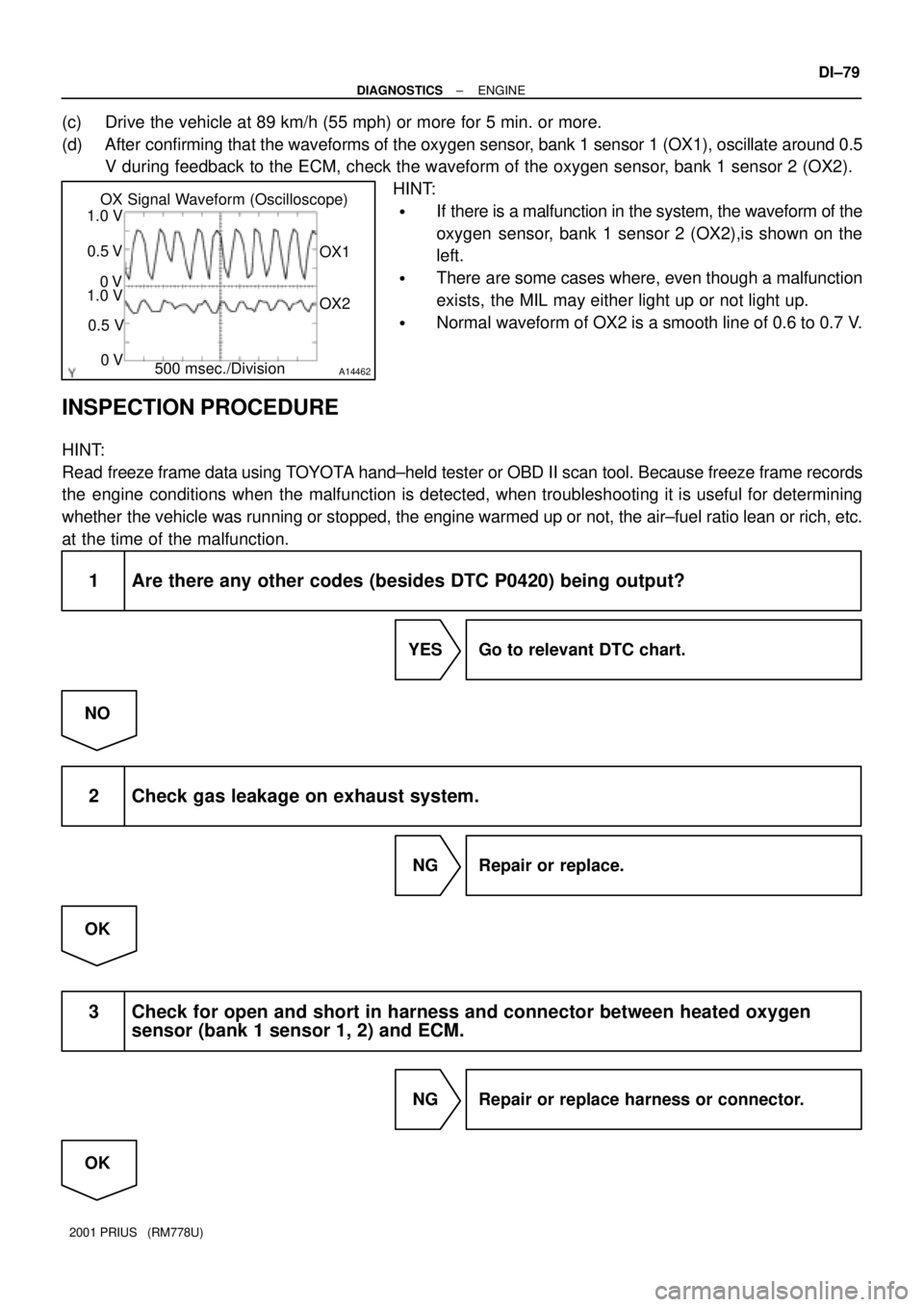
A14462
OX Signal Waveform (Oscilloscope)
500 msec./DivisionOX1
OX2 1.0 V
0.5 V
0 V
1.0 V
0.5 V
0 V
± DIAGNOSTICSENGINE
DI±79
2001 PRIUS (RM778U)
(c) Drive the vehicle at 89 km/h (55 mph) or more for 5 min. or more.
(d) After confirming that the waveforms of the oxygen sensor, bank 1 sensor 1 (OX1), oscillate around 0.5
V during feedback to the ECM, check the waveform of the oxygen sensor, bank 1 sensor 2 (OX2).
HINT:
�If there is a malfunction in the system, the waveform of the
oxygen sensor, bank 1 sensor 2 (OX2),is shown on the
left.
�There are some cases where, even though a malfunction
exists, the MIL may either light up or not light up.
�Normal waveform of OX2 is a smooth line of 0.6 to 0.7 V.
INSPECTION PROCEDURE
HINT:
Read freeze frame data using TOYOTA hand±held tester or OBD II scan tool. Because freeze frame records
the engine conditions when the malfunction is detected, when troubleshooting it is useful for determining
whether the vehicle was running or stopped, the engine warmed up or not, the air±fuel ratio lean or rich, etc.
at the time of the malfunction.
1 Are there any other codes (besides DTC P0420) being output?
YES Go to relevant DTC chart.
NO
2 Check gas leakage on exhaust system.
NG Repair or replace.
OK
3 Check for open and short in harness and connector between heated oxygen
sensor (bank 1 sensor 1, 2) and ECM.
NG Repair or replace harness or connector.
OK
Page 684 of 1943
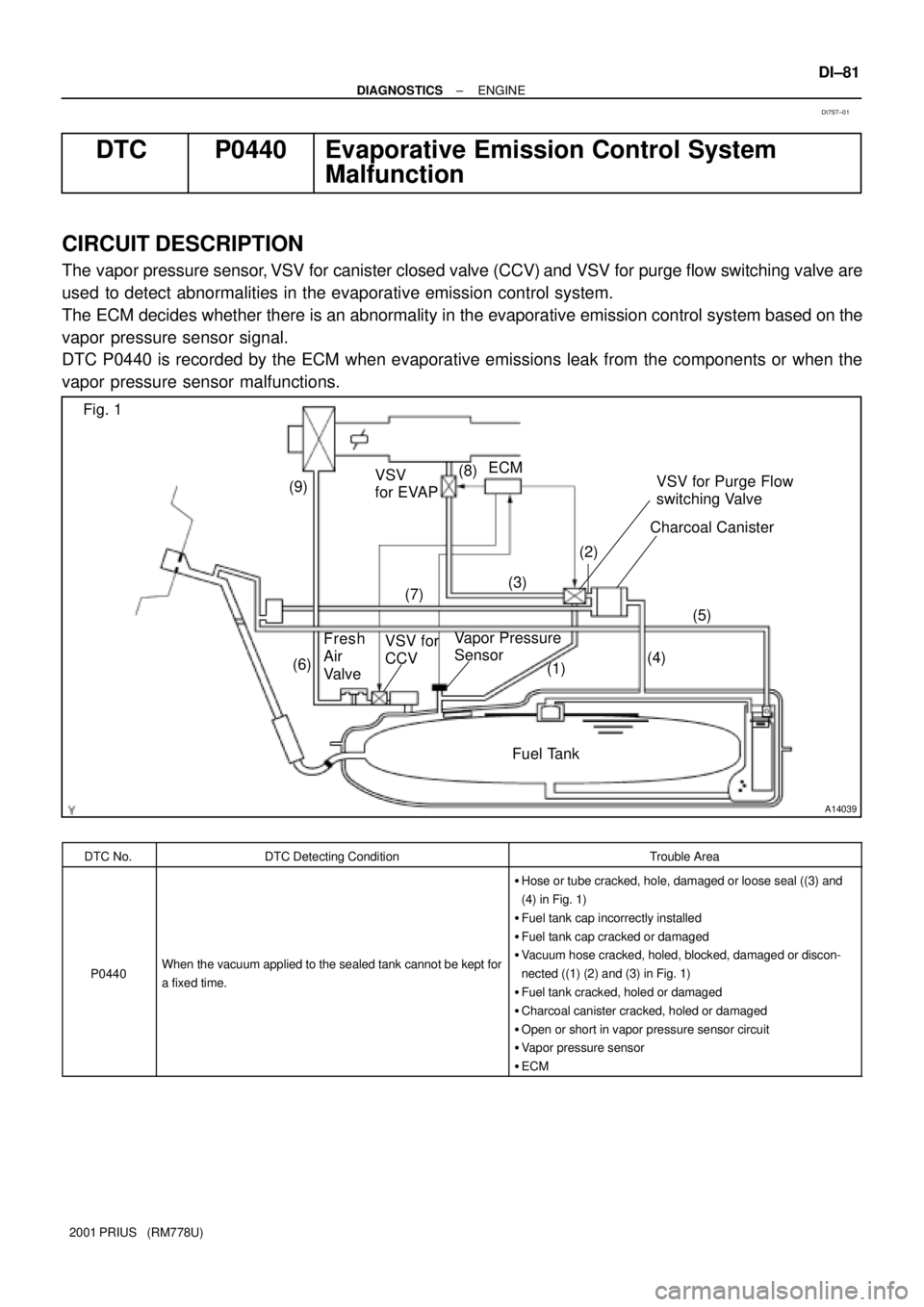
A14039
ECM
VSV
for EVAP
Charcoal Canister
Fuel Tank Fig. 1
(3) (8)
(9)
(1) (7)
Vapor Pressure
Sensor VSV for
CCV(4)(5)
(6)(2)
Fresh
Air
ValveVSV for Purge Flow
switching Valve
± DIAGNOSTICSENGINE
DI±81
2001 PRIUS (RM778U)
DTC P0440 Evaporative Emission Control System
Malfunction
CIRCUIT DESCRIPTION
The vapor pressure sensor, VSV for canister closed valve (CCV) and VSV for purge flow switching valve are
used to detect abnormalities in the evaporative emission control system.
The ECM decides whether there is an abnormality in the evaporative emission control system based on the
vapor pressure sensor signal.
DTC P0440 is recorded by the ECM when evaporative emissions leak from the components or when the
vapor pressure sensor malfunctions.
DTC No.DTC Detecting ConditionTrouble Area
P0440When the vacuum applied to the sealed tank cannot be kept for
a fixed time.
�Hose or tube cracked, hole, damaged or loose seal ((3) and
(4) in Fig. 1)
�Fuel tank cap incorrectly installed
�Fuel tank cap cracked or damaged
�Vacuum hose cracked, holed, blocked, damaged or discon-
nected ((1) (2) and (3) in Fig. 1)
�Fuel tank cracked, holed or damaged
�Charcoal canister cracked, holed or damaged
�Open or short in vapor pressure sensor circuit
�Vapor pressure sensor
�ECM
DI7ST±01